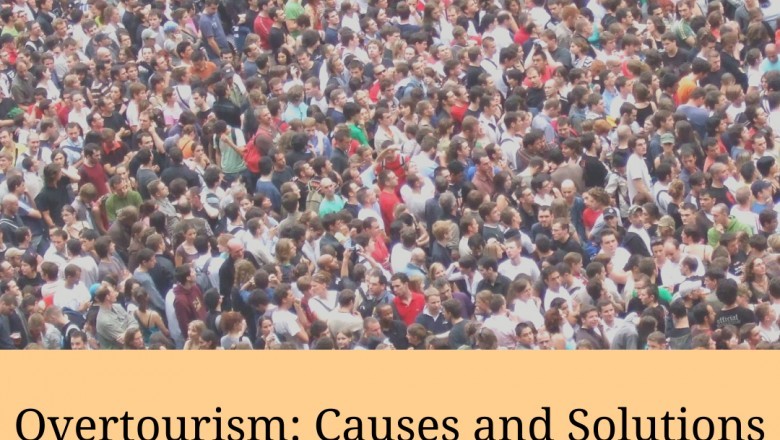views

Overtourism
The United Nations World Tourism Organization (UNWTO) defines overtourism as "the impact of tourism on a destination, or parts thereof, that excessively influences perceived quality of life of citizens and/or quality of visitor experiences in a negative way". Overtourism though existed from the 1950's but came to light only in 2017 when the residents of Europe could take it no more and felt enough is enough. Well, what exactly is OVERTOURISM? It is overcrowding at one spot or destination and negatively impacting the life of locals, their environment and their surroundings. Making it very hard for them and disrupting their lives. Years ago as the population was less it went unnoticed but now since it has almost tripled the effects can be felt by the locals. It being a billion dollar revenue generating industry, many cities and their local authorities found every possible way to boost tourism, ignoring the effects it had on the locals and the tourist destinations. Until one fine day there were mass protests held in Europe in 2017. They insisted that action should be taken to stop tourists and that is when the world too started taking action. There were banners everywhere and graffitis written 'TOURIST GO HOME” and tourist vehicles were vandalised. No doubt that tourism has benefitted many cities, brought immense wealth for some, saving them from financial crunch, helped conserve animals in grave danger and conserve historical monuments, made known places which were unknown but overtourism could be very disturbing.
EFFECTS OF OVERTOURISM
As we all know global tourism will continue to grow inspite of the pandemic. For now it is reduced but will bounce back. Hence it is important that we understand what is overtourism and how we can help curb it. When tourists crowd at a single location in large numbers it ruins the historical sites, the local environment, creates infrastructural damage, languages and cultures get lost, roads get jammed with tourist vehicles, wildlife is scared away, danger of delicate structures crumbling down, pollution, increase in carbon footprint, piling up of dirt and trash by unconcerned travelers, increase in real estate and noise pollution thus making life for the locals very hard.. It is necessary that travelers help turn the negativity to positivity and also save natural and historical treasures.
In the year 2050 population is expected to touch 10 billion and out of that 3 billion people are expected to be tourists. If we don’t take the initiative now we risk losing our tourist destinations and heritage sites. Tourists travelling in large groups make it difficult and uncomfortable to view tourist destinations apart from taking a lot of time if queue is required, even if the crowd is to be distributed. The most annoying thing for residents are tourists unruly behavior and unconcern for the destinations. It is necessary for tourists to learn and understand the host country culture before arriving to the destination. When people go in large numbers especially during peak season’ cleaning the city becomes another big issue for the municipalities and also an increase in carbon footprint. This could affect fragile and delicate monuments. Where there is a large crowd there tends to be an increase in crime too, which calls for more security measures borne by the governments. Crime against tourists is another lengthy legal process to deal because it becomes a worldwide issue, with over exaggerating media focus. In some cases negative publicity too. Rental sites such as Airbnb have many private short-term rentals and accommodations usually taken by one person for this purpose. They hold multiple units to make money during the peak season. They charge exorbitant rates which makes it difficult for locals to get accommodation or pay such high rents. In this case local tenants are in a fix including many number of students being chased away. Some cities have lost their traditional language and local way of life by adopting new languages and culture to cater to tourists.
REASONS FOR OVERTOURISM
One of the main reasons for overtourism is increase in population. Secondly the growing of the middle income group to millionaires and billionaires, who can afford luxury trips and they are expected to rise to 4.2 billion by 2022.Thirdly the growing technology with social media platforms where one tourist tags a certain place he or she has found along with co ordinates. Then is the race and rush to that place getting it over crowded. This is further advertised and promoted through influencers. The other reason is cheap budget flights and cruise tickets since some countries have no tax or VAT on air fuel. The cruise liners use cheap fuel oil, which increases carbon emission. When a train ticket from Auckland to Wellington is around $120 and a trip to Sydney is $200-250 , then Sydney is a better option. During seasons with discount and frequent flyer points, it could be plus or minus around the similar price.
The other reason is giant cruise ships which carry about 8000 to 10,000 people, which is almost the size of a small town. For smaller island nations that is almost 6-10 times the size of the national population. Such number of cruises arrive 2-5 times in a day. I remember seeing ships almost the size of the neighbouring skyscrapers looking just like another building docked at the viaduct harbour in Auckland. Couple of times haven't even realised it is a ship unless I see huge amount of people taking pictures of these giant ships. When we see the streets flooded then we know a cruise has arrived. City centers like Westfield, britomarts used to be filled including food courts. Another craze nowadays is people forming groups or friends on social media becoming travel buddies, to travel together. It’s ok if it’s a small group but if it’s going to be a large one then it’s going to be a problem. Most of all, at some point of time each country has promoted their locations paying heaps of amounts to celebrities to advertise, market and promote their tourist destinations to attract tourists. Well if advertising now, then they should have all these facts too as it is very important to educate tourists. Movie and TV series too have helped overcrowding.
HOW DOES OVERTOURISM AFFECT THE CITIES
1) Thailand’s Maya Bay was closed to the public for rejuvenating program. Tourists started overcrowding 18 years after it was made famous by the 2000 film The Beach. The high number of tourists caused excessive damage to the local ecosystem. 80% of the coral bay was dead. To revive it, under the rejuvenating program they replanted 10,000 corals.
2) Previously as I have mentioned about how some countries tourists outnumber the national population. Below we see a list of an index created by the Australian travel company Intrepid of the top 10 countries which are suffering from Overtourism. It was taken in the year 2016 as the latest updated one is not available. We can see that Croatia is 14 times more than it’s national population.
Now we can understand why do locals get so annoyed with tourists. Imagine day in and day out dealing with such huge number of tourists. A very heavy burden on land, it’s residents and tourist destinations.
3) Many beautiful places which were open once are all closed now for tourists and banned. All due to overtourism, indecent and unruly behavior by tourists and illegal poaching. Just to mention a few are :- Train street, Hanoi, Vietnam, ‘I am sterdam' sign board was removed to stop tourists from flooding the place, Spanish steps spoilt with red wine stains and sticky chewing gum, which cost the Roman government $1.68 million to clean in 2016. The Komodo islands, where smugglers were caught for illegal poaching selling 41 komodos for $31,000. The place is completely off limits now to tourists as the population of the Komodo dragons are decreasing . The Fjadrargljufur canyon in Iceland too is banned as people were found sneaking there in the nights. Reckless amount of damage has forced the government to shut it.
4) Overtourism is not always from tourists though, sometimes it can be from neighbouring villages and states too. In India many religious places get overcrowded. It is a country that has many ancient temples and religious festivals being held for ages. International travellers often travel to places such as Agra, Goa, Alleppey and many more. Locals travel to places like Varanasi where Kumbh Mela is celebrated every 12 years. The Kumbh Mela Force a government organisation said in the year 2021 from Jan 14 to April 27 about 9.1 million people attended inspite of the covid restrictions. They took the holy dip in river Ganga. The Ganges is one of the highly polluted rivers in the world. It is one of the world’s longest rivers and highly contaminated with dumping of raw sewage and chemicals. Though efforts are on to clean it. The Sabarimala temple in Kerala, has 40-50 million devotees every year, Tirupati in Andhra Pradesh has 50000-100,000 devotees every day, 30-40 million in a year. Jagannath Puri rath yatra the world’s largest chariot festival is usually attended by 1.5-2 million devotees. Though this year due to covid there were many stringent conditions. But whenever this is held there is always stampede, people die or shock circuit many such incidents.
5) Some of the movies that have attracted overtourism is Game of Thrones to Iceland and Harry Potter to Scotland. It’s an endless list and so are some of the music videos.
HOW ARE COUNTRIES COMBATING OVERTOURISM
1) Italy’s Cinque Terre has limited to the number of hikers,
2) Amsterdam is focusing on tourist redistribution techniques. Only 4 guests are allowed at a time and one cannot stay for more than 60 days. Netherlands is not promoting Amsterdam as tourist destination instead concentrating on other smaller cities and towns, ban on Red light district tours, tax increase for visitors staying overnight, canal boat tours will have an increase in entertainment tax. This tax helps the municipality keep the city safe and clean and to maintain other infrastructures such as bridges, quays, walls, streets and sidewalks.
3) In Asia, governments have closed entire islands to allow recovery,
4) The Iceland government has launched a Tourist Site Protection Fund, and Reykjavík has banned permits for new hotel construction downtown
5) Gorilla tracking in East Africa such as Rwanda, only eight permits per day are issued to track each gorilla family, and it’s very expensive around $500 and above. Permit prices range from US $500-$750. Tourists have been agitating about the high cost of permits but this has helped keep the forests intact and the once threatened species has been growing.
6) At Spanish steps the Roman government slaps a fine of $280-488 if anyone sits on the steps.
7) In Dubrovnik, 80% of the souvenir shops are shut down, restricting cruise ships to 2 per day, ban on new restaurants and no new outdoor tables for restaurants and bars. Only fixed number of prebooked slots for tourist buses and coaches to avoid overcrowding, for cruise passengers no shuttle buses, the public buses will be used, doubling overnight tax on Airbnb apartments.
8) Santorini limited 8000 cruise passengers per day, the only transport is donkey taxi which should carry only 100 kgs or one fifth of the donkey weight
9) Venice has had to deal with tourists bad behavior, authorities have come with several measures to control the tourism that risks destroying their city. Ban on new hotels and fast food premises unless of course it is of public interest. Redirecting tourists to other lesser known streets. Venice has put in a lot of effort to maintain their historic feel, including banning large cruise ships, and has long mulled the imposition of a daily tourist quota to prevent overcrowding. There were rumours of banning suitcases with wheels since it caused too much noise pollution but the government has confirmed it is only for vehicles such as carts that have been banned. For tourists it will be difficult as some streets are vehicle free, so the suitcases are exempted.
10) In Catalan city Barcelona, has banned groups from La Boqueria food market and cracking down on illegal lets. From the overnight tourist tax they have doubled the number of buses from beach to town which used to be packed by tourists. Also advertising little known places. They have started culture marketing, getting cultural institutions to encourage tourist visits like the Liceu opera house. The final marketing push is the Barcelona locals itself. They don't want the locals to perceiving that tourism is something negative.
11) Antarctica and the Galapagos Islands are having restrictions on cruise ship sizes and the number of passengers disembarking at any one time which also ensures sustainable tourism.
12) The Inca Trail, issues only around 200 trekking permits per day and it is mostly sold out months in advance.
13) Reykjavik has banned permits for new hotel constructions at downtown.
14) Officials in Barcelona Officials in Barcelona, one of the world’s busiest cruise ports, have promised tighter controls on mass tourism, short-term apartment rentals, hotel development, and other challenges.
15) Pressure for change comes less from tourists than from locals and preservationists and local authorities are forced to increase prices for various tickets, rides, fines and added tax. So traveler’s should be prepared for all this henceforth. Some countries have limited the tourist guides to have only 20 tourists, coming down from 60.
HOW CAN TOURISTS HELP STOP OVERTOURISM?
Be a responsible tourist and learn to respect that country’s people, culture, tradition and language. Travel in small numbers, not only for overtourism but as a precautionary measure even from the covid pandemic. As far as possible avoid travelling during peak seasons, try travelling during the 'shoulder season' which is a couple of days before or after peak season so you will experience a similar kind of climate. Many cities have been victims of overtourism, so do your research before you travel. Find out about the weather and calamities that usually occur there, so you are prepared before hand. See if you could make some friends before leaving or on arrival. Try to stay or share a local place that way you could have the support of your local host. Try to learn and understand more if staying with locals, but be careful not to trust your host completely, atleast till you get to know them.
Opt countries that don’t have many tourists, you will be surprised you might get a warm welcome from them and get some good friends too. While we were in NZ we used to just go for long drives and believe me we have found such lovely places to spend time, and have revisited those places. I prefer to stay away from large crowds, can get suffocating at times. So explore, but do not tag people on social media especially giving the co ordinates. Know the countries rules and regulations, traveler’s pledges it it’s there. In NZ you cannot take the green stones it’s sacred to the Maoris. There are many countries which don’t allow travellers to take pebbles, sand etc as souvenirs. Be careful you could be fined heavily. If buying local things look for the local organisation or brand logos or labels so that you know you are helping the locals. Be polite, respectful and try to blend in with the crowd. Keep the places clean and free from pollution and that means even noice pollution.
Following such things will reduce the friction between the locals and tourists and make it a lifelong nice relationship. As far as possible use local currencies. If possible inform you embassy or high commission once you land there, so if any untoward incidents should happen, they will be there. Avoid places where it is overcrowded. It’s not always the tourists who overcrowd, sometimes it’s their local festivals and its mostly people from neighbouring villages or towns. So find out all this before you leave. Overtourist countries can be given a break as they are too fed up of tourists. Go to places where they need you. Go to villages, listen to their music, enjoy the scenic beauty, learn their culture, don’t go as a tourist go as though you are one among them. You are going there to relax, stay away from the hustle and bustle of the maddening crowd and go where you can relax, so you can leave with a change in you and benefitting from the much wanted long break. Let it be a fruitful relationship between you, the host and the destination. Be in small numbers that will help you to see and understand every detail on the site or monuments. Let the locals feel, that you going there is contributing in some way to their place or people. This will change the negativity to positivity. In some places the locals peak time will be different, so you can visit places before or after the local peak hours. If it’s safe you can use the public transport and if not in peak hours you probably might get an empty one at least not a jam packed one. While searching for hosts on sites like Airbnb don’t choose those who have many places to rent. Since some of these people take many units temporarily to let it out in the season. By trying to follow some of these you will be avoiding a chance of having a bad experience you might regret later. So keep all these in mind and protect every tourist destination. contact tourist bureaus and get all the brochures or details from the airport. Give feedbacks, opinions, surveys or online reviews whatever will help them better or improvise it make it better for tourists in future. Hope this was helpful. Enjoy your trip and stay safe.












